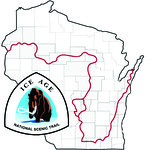A Kettle is formed when:
- A block of ice breaks away from a receding glacier.
- The ice then gets buried by glacial outwash or glacial till.
- When the ice blocks eventually melt, kettle holes are left behind.
In most cases, kettle holes eventually fill with water, sediment, or vegetation.
There are several types of kettles:
If the kettle is fed by surface water or underground rivers or streams, it becomes a kettle lake.
If the kettle receives its water from precipitation, the groundwater table, or a combination of the two, it is called a kettle pond.
- Kettle ponds that are not affected by the groundwater table will usually become dry during the warm summer months.
A kettle pond may be called a kettle wetland if it is vegetated.
- If water in a kettle becomes acidic due to decomposing organic matter, it becomes a kettle bog.
- If the underlying soils are lime based and neutralize the acidic conditions, it becomes a kettle peatland.
If the kettle is not fed by a spring or stream, and it lies above the water table, it becomes a dry kettle.
If the block of ice was carried away from the edge of the glacier and surrounded by outwash sediment, the area surrounding the kettle may be fairly flat.
If the block of ice was left behind at or near the edge of the melting glacier, the area surrounding the kettle may be hilly due to moraines or kames.
Since the trail at these locations is part of an abandoned railroad, the landscape was altered to create the relatively flat grade for the tracks. This alteration resulted in dividing the kettles. The trail effectively created two smaller kettles at each location. The kettle characteristics of at least one of the smaller kettles at each location was changed as a result.
 IATCC is the cache designation to highlight a series of EarthCaches along the Ice Age National Scenic Trail grouped into a special category called "ColdCache."
IATCC is the cache designation to highlight a series of EarthCaches along the Ice Age National Scenic Trail grouped into a special category called "ColdCache."
The Ice Age Trail is one of eleven National Scenic Trails designated by the National Park Service. This unique trail is entirely within the state of Wisconsin and follows along the terminal moraine of the most recent glacier which retreated about 10,000 years ago.
This project is supported by the Ice Age Trail Alliance (IATA). The goal is to bring more visitors to the trail and promote public awareness, appreciation, and understanding of Wisconsin’s glacial landscape.
The IATA has created an awards program to encourage visits to the trail and ColdCache sites. This awards program is separate from, and in addition to, any other Geo- or EarthCache awards program.
A current list of approved ColdCache sites can be found on the “IATCC Bookmark List”. More information on the Ice Age Trail Atlas, the Companion Guide, the ColdCache Project and Awards Program can be found on the “ColdCache Webpage”
DNR Permission
The Geocache Notification Form has been submitted to Mike Repyak of the Wisconsin DNR. Geocaches placed on Wisconsin Department of Natural Resource managed lands require permission by means of a notification form. Please print out a paper copy of the notification form, fill in all required information, then submit it to the land manager. The DNR Notification form and land manager information can be obtained at: www.wi-geocaching.com/hiding
Resources
Geology of the Ice Age National Scenic Trail; by David M. Mickelson, Louis J. Mahler Jr., and Susan L. Simpson
To claim this find:
1. Describe the differences between the two smaller kettles at each location.
2. Which one was probably most affected by the division? How and / or why?